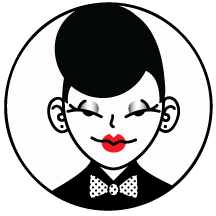JAZZ BELL (they/ them) is a trans nonbinary, intersex, fat, neurodivergent, multiply disabled, biracial (Han Chinese by way of Taiwan / white) visual artist, poet, care worker, consultant, and disability justice dreamer. Their poetry has appeared in Muzzle, Nat. Brut, Button Poetry, Write About Now, and elsewhere. They are a 2018 Pink Door Fellow and a 2020 Interfaces Fresh AIR resident. Their Visual Art has appeared in Crab Fat Magazine, Persephone's Daughters, on the cover of George Abraham's poetry collection The Specimen's Apology, on the cover of Ebony Stewart's chapbook Ricochet, and in Transgender Studies Quarterly.
make-up: covid era healing ritual
jazz bell
content warnings: mentions of a suicide attempt, psychiatric institutionalization, ableism, transphobia, fatphobia, intersexism, and COVID
Before COVID, I was out as nonbinary but was still acting like a woman to get by. I wore what I call my “white social worker cosplay clothes” to my internship (you know . . . the long skirt, the cardigan, the top that’s way more modest than I would choose for myself). Being as disabled as I am, I didn’t have the energy to even think about the way I would like to present aesthetically if I wasn’t so tired of oppression. I was trying to get to tomorrow.
Gender expression has always been confusing to me. As an intersex person, I have been punished throughout my life for the parts of me deemed “biologically” un-woman. I spent a very long time trying to appear as high femme as possible to ward off further discrimination, but I also grew to consider these aesthetic expressions as an extension of my visual art and creative expression. It’s complicated.
So complicated apparently, that I was institutionalized after a suicide attempt (of course, institutionalization, paired with the medical abuse I experienced there, only made those feelings worse). A few days later, COVID hit.
Needless to say, I was having a pretty shit time. I, along with thousands of other disabled people, were (once again) thrust into isolation. An isolation that many of us are still experiencing. In all this though, I was truly alone for the first time in a while. I started to realize nothing I was doing in my life was sustainable for my fat, disabled, intersexed body. I had more time than I’d ever had to ask, “what do I want when no one is watching?”
Turns out, the answer to that was cool makeup, cool earrings, cool hair ornaments, a beard, and a low voice. I started taking testosterone.
Now, I don’t know where disability dysmorphia ends and where gender dysphoria begins, but I don’t really think it works like that. All I knew was that no matter what I tried, no one could ever really perceive me the way I wanted to be perceived; no amount of makeup, craft, or intention was going to cut through the ableism and transphobia and intersexism that people hold.
Instead of trying to “express my gender” in a way others could understand, I tried to express my longing for nature and the ways I see it reflected in myself. In the beginning of COVID, I longed for nature in the absence of touch, but most nature spots were not accessible for me either. Nature is also a deep part of my spirituality, and I have always felt spiritually disconnected through the enforced separation of disabled people from natural spaces.
I started painting my own face with things that reminded me of what I couldn’t access myself. Golden eyeliner for sun rays, blues for waves, reds for fires, asymmetric looks because nature is not symmetrical and neither am I. Nature is genderfucked, and so am I.
Makeup became a grounding ritual that kept me alive during the first part of COVID. I became less afraid of myself. Of course, it didn’t stop the ableism and transphobia—I never expected it to. What you see is not my gender, but a self-affirmation, a spiritual armor, a commitment to imagine myself as part of the worlds I want to live in when I talk about disability justice or the possibilities of gender or fat liberation.

